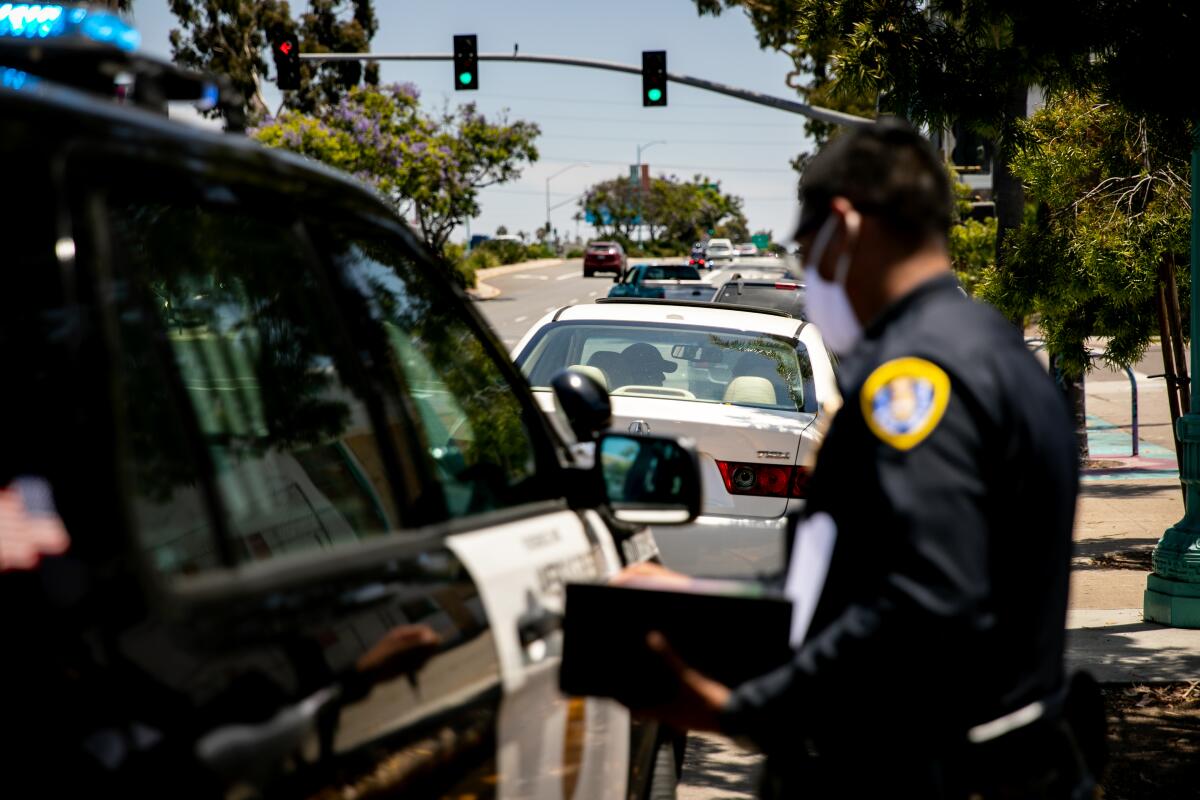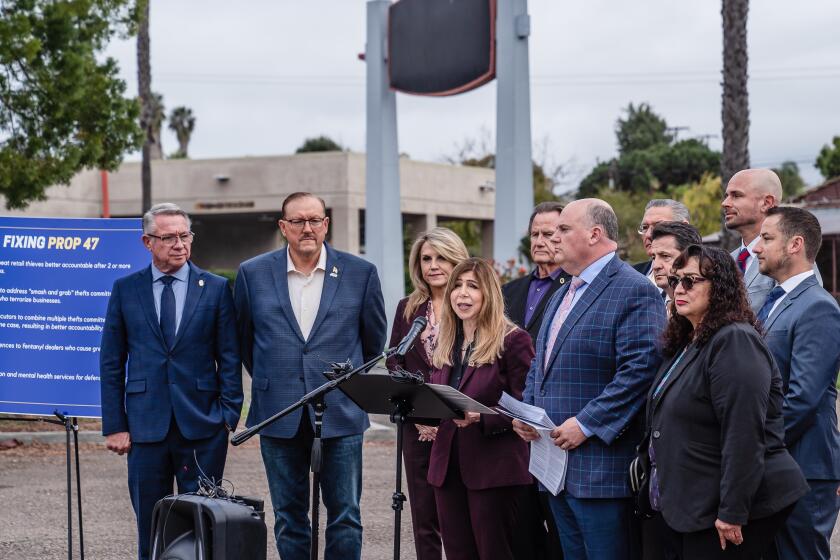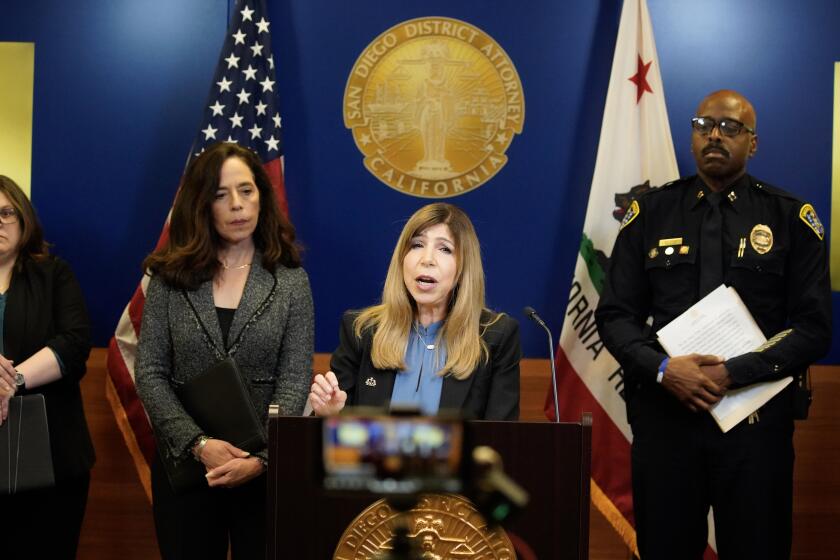Nearly all major crimes increased last year in San Diego, police say

Biggest increases seen in hate crimes, which saw a 77 percent spike, and vehicle thefts, which increased 25 percent. The increases mirror those seen across the country.
The city of San Diego saw increases in nearly every category of major crime in 2021, police officials said, mirroring a trend seen in other large cities across the nation.
Police leaders presented the findings at a San Diego City Council meeting on Tuesday.
Across the city, crime increased about 13 percent, according to the latest figures. The year’s violent crime rate of 4.2 crimes per thousand residents was the highest the city had seen in nearly a decade, and the property crime rate of 19.6 crimes per thousand residents was the highest since 2016, department officials said.
Vehicle thefts spiked 25 percent when compared with 2020 figures, and rapes increased by 18 percent. Aggravated assaults and thefts also saw double-digit jumps, while burglary and homicides rose a couple of percentage points each. Many of the increases persisted when comparing 2021 and 2019 — the year before the coronavirus pandemic prompted widespread lockdowns.
Hate crimes also saw a 77 percent increase last year, a surge that alarmed council members.
Robbery was the only major crime to see a decrease, falling about 10 percent when compared with 2020.
San Diego police Chief David Nisleit said the havoc wrought by the pandemic likely fueled some of last year’s increases — both locally and nationally.
“It’s COVID. It’s people being out of work, kids being out of school, just the anger and the frustration levels of everything over the last two years,” Nisleit said. “I think we need to acknowledge the last two years have been difficult on everybody.”
Still, experts say crime in San Diego remains at near-historic lows when compared with the rates seen in the 1980s and 1990s. Both violent and property crime rates have held fairly steady over the last decade, and, despite the increases seen in 2021, current crime rates are comparable to the late 1950s, when the city’s population was much smaller, police officials said.
“We still are at historic lows, comparably,” said Cindy Burke, the director of research and program management at the San Diego Association of Governments, also known as SANDAG.
Other big cities, like Los Angeles and New York, reported similar increases.
“Police departments across the nation are combating rises in crime, and although San Diego historically ranks as one of the safest big cities, our city is also seeing an increase in crime,” Nisleit said.
In addition to most major crimes, several specific crime types also increased.
Hate crimes jumped from 26 in 2020 to 46 in 2021, and more than half were racially motivated, police said. Anti-Black bias accounted for 10 cases, while anti-Asian and anti-Hispanic bias accounted for four cases each. Anti-White bias was involved in two cases, and five cases involved bias against someone who was multiracial or some other race.
Bias against someone’s sexual orientation accounted for more than a quarter of hate crimes, and religious bias made up another 20 percent. Of the nine anti-religion hate crimes, seven were anti-Semitic in nature.
“As a member of the LGBTQ community, I am concerned,” said Councilmember Jennifer Campbell. “Just because equal rights for the LGBTQ community are advancing quickly, the reality is that homophobia is still impacting us, from microaggressions all the way to hate crimes described in this report.”
Overall, domestic violence crimes increased about 4 percent, but domestic violence crimes involving firearms increased nearly 70 percent. Gang crimes increased about 8 percent, and gang homicides increased 70 percent, from 10 in 2020 to 17 in 2021.
“We had a very busy summer — we saw a lot of shootings in the summer months and that was citywide,” Nisleit said. “Every command is seeing gun violence.”
To address rising crime, the department recently added a sixth homicide investigation team and a new ghost gun investigation team. The department is also leaning into intelligence-led policing strategies that help zero in on specific crimes and offenders and regularly participates in walks with community groups in various neighborhoods.
The Police Department also partnered with LGBTQ and Asian American and Pacific Islander businesses to designate the establishments as safe zone to report hate crimes.
Nisleit noted the city’s homicide rate remains one of the lowest among the nation’s largest cities and highlighted the department’s homicide clearance rate of about 75 percent. Across the country, homicide clearance rates hovered around 60 percent in 2019, FBI statistics show.
Police officials said toward the end of Tuesday’s presentation that, of 10 of the country’s largest cities, San Diego had the fewest number of officers per 1,000 residents at 1.3.
After the department’s presentation, City Council President Sean Elo-Rivera urged the city to invest in strategies designed to prevent crime and violence from happening in the first place. He brought up reducing substance abuse, confronting the city’s gun problem, reducing harmful effects of the justice process and better engaging and supporting young people as examples — all solutions that have been discussed before by Councilmember Monica Montgomery Steppe, Elo-Rivera said.
Both Elo-Rivera and Montgomery Steppe noted that many young people lost access to their social and emotional support systems during the pandemic, with the closure of schools and the cancellation of sports and other extracurricular activities. This may have led to an increase in crime among young people, the council president said.
“We should also note what did not coincide with increases in crime,” Elo-Rivera said. “There were no budget cuts to police spending in fiscal year 2021-2022. In fact, the police budget increased by millions. In other words, there’s no reason to believe that additional increases in spending on policing will solve this by itself.”
Nisleit acknowledged that policing isn’t upholding public safety alone.
“We need to work all together,” he said. “It’s not just law enforcement, it’s our community, it’s our elected officials, to make certain that we’re driving down this violence.”
SANDAG is expected to release violent and property crime statistics for the whole county in several weeks.
The latest news, as soon as it breaks.
Get our email alerts straight to your inbox.
You may occasionally receive promotional content from the San Diego Union-Tribune.




